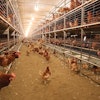
In the egg industry, billions of day-old male chicks are killed each year the world over because they are not commercially profitable.
Until the 1960s, chickens were raised in people’s backyards. Hens layed eggs, and once their productivity declined they were used as stewing hens, while male chicks were used for meat production. Today, however, with an increasing global population and a growing demand for eggs and poultry meat, the industry has responded by developing different breeds, with egg-laying breeds raised for egg production only, and others raised only for meat production.
As a result, male layer breed chicks are discarded because they do not lay eggs and are not considered suitable for meat production.
However, concerns over animal welfare are growing in many developed countries, including Germany, the Netherlands, the United Kingdom, the U.S., Australia and New Zealand. The killing of day-old male layer breed chicks has been criticized in public debates and increasingly in political discussions due to ethical concerns.
The egg industry has therefore been exploring this issue in order to find a suitable solution that benefits society and the industry itself.
Potential alternative methods have been identified, such as the use of combination breeds (dual purpose: suitable for egg and meat production) and in ovo determination of the embryo’s sex before incubation, or early on in the egg incubation phase, to avoid the potential pain and suffering of the existing euthanasia methods. Currently, however, these alternatives are not use in practice.
In contrast, in Thailand most day-old male layer breed chicks are not killed, but are instead used for meat production. Thailand is one of the world’s leading poultry producers with, according to the Office of Agricultural Economics, almost 1.5 million tons of broiler meat and 1.1 billion eggs produced in 2012.
Male layer chicks and the poultry meat industry
Every year, almost 40 million male layer chicks are utilized in the Thai poultry meat industry. The majority of day-old layer cockerels are raised for meat production and only a small number is killed for animal feed.
After the sex of chicks is identified in the hatchery, healthy male layer chicks are sorted for meat production. Male chicks are sold cheaply, at a price of US$0.02-0.03 per chick, compared with US$0.68-0.77 for female chicks, to private and contract farmers.
Male chicks are raised like broilers, but require less protein and energy due to their slower growth rate. In response to this, the industry has developed special feed for male chicks containing optimal protein and energy, which is also cheaper than broiler fodder.
Male chicks are fed for 60 days to reach a weight of 0.8-1.2kg at slaughter. The selling price for male chicken meat is higher than conventional broiler meat, yet still slightly cheaper than native breed chicken meat.
Male chicken meat is predominantly used to make roast chicken, a traditional Thai dish served with papaya salad and steamed glutinous rice. Consumers in the Northern region prefer male chicks that weigh 1.0-1.2 kg, while the Northeastern region prefers chicks that weigh 0.8 kg. For this reason, farmers in the Northeastern region can generate higher profits as it takes less time and feed to raise chicks that meet consumers’ requirements.
Fully integrated poultry companies in Thailand have invested in the male chicken meat market by establishing brands, convenience stores and restaurants, such as Five Star Chicken (owned by CPF) and Kaiyang SF (owned by SF Group) to market their products.
In addition to the high demand for male chicken meat in Thailand, roast chicken dishes are now also in high demand in Laos, Vietnam, Cambodia and China, providing an opportunity for Thai companies and others to increase their investments by establishing production bases in these countries and expanding their markets.
The future of day-old male chicks
As concerns over animal welfare continue to grow in developed countries, the poultry industry needs to find alternative solutions for day-old male chicks, particularly if a ban on the killing of male layer chicks becomes more widespread.
The success of male chicken meat production in Thailand lies in the market, driven by high consumer demand, sound consumer perception and acceptance of the product.
Although European countries may still have smaller markets for male chicken meat products, production for domestic consumption and for export to Asian markets are possible opportunities. The egg industry needs to provide consumers with more information in order to improve its image and consumers’ acceptance, and look at export markets. This alternative use of male layer chicks for chicken meat production could minimize ethical concerns and improve the egg industry’s image.
The case of male chicken meat production in Thailand shows that the egg industry could successfully replicate this alternative model for the use of day-old layer cockerels if there is enough of a market and sufficient consumer demand. Following Thai practice could not only set an example for other egg-producing countries, but also make male layer chicks a valuable product.

















